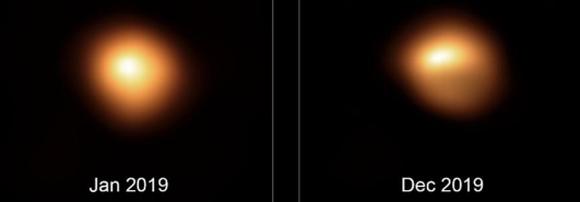
Betelgeuse, with and without dust cloud
We recently posted about the red giant navigational star Betelgeuse in the constellation Orion, which was observed to be growing significantly dimmer. Not a little dimmer but about 40% dimmer. Some astronomers speculated that the dimming suggested that the star may be close to exploding into a supernova as its core collapses. They say that this could happen anytime within the next 100,000 years, or so, a relatively narrow window in astronomical time, if less so from a merely human perspective.
Not long after our post, blog reader Kevin commented that the star had begun to brighten again. (Thanks Kevin for the heads-up.) So what is going on?
As reported by Forbes, a new study suggests that the star is not about to explode, it is just a bit dusty.
A new paper accepted to Astrophysical Journal Letters and published on the preprint site arXiv entitled ‘Betelgeuse Just Isn’t That Cool: Effective Temperature Alone Cannot Explain the Recent Dimming of Betelgeuse’ by Emily Levesque, a UW associate professor of astronomy, and Philip Massey, an astronomer with Lowell Observatory, suggests that Betelgeuse isn’t dimming because it’s about to explode. …
The evidence suggests that Betelgeuse has probably “sloughed off” some material from its outer layers, something that is common with red supergiant stars. “We see this all the time in red supergiants, and it’s a normal part of their life cycle,” said Levesque. “Red supergiants will occasionally shed material from their surfaces, which will condense around the star as dust. As it cools and dissipates, the dust grains will absorb some of the light heading toward us and block our view.”
So, apparently, Betelgeuse has not been getting dimmer at all. We have just been seeing through a massive dust cloud that made it look dimmer.
As we have noted before, the apparent dimming we have recently observer took place over 640 years ago. Betelgeuse is 642.5 light-years from the earth, so the light we see today has had to travel for 642.5 years through space for us to see it. Due to the distances between the stars, when we look a the night sky, we are literally looking back in time.

The light took longer than 642.5 years!
Try again:
Light Year:
a unit of astronomical distance equivalent to the distance that light travels in one year, which is 9.4607 × 1012 km (nearly 6 trillion miles).
Worm Moon, because the worms start to move as the soil thaws.
Northern Hemisphere will get to see a cosmic triple play on March 20, as a “super worm moon” lights up the vernal equinox. According to astronomy website EarthSky.org, a full moon has not landed this close to the first day of spring since the year 2000, and the two celestial events won’t happen less than a day apart again until 2030.
I will miss Betelgeuse, a superb name, a superb star to look at, easy to find and so interesting.
I also sailed on an ex-Rotterdam Pilot ship turned survey ship of the same name which was nicknamed “Beetlejuice” much to the skippers chagrin.